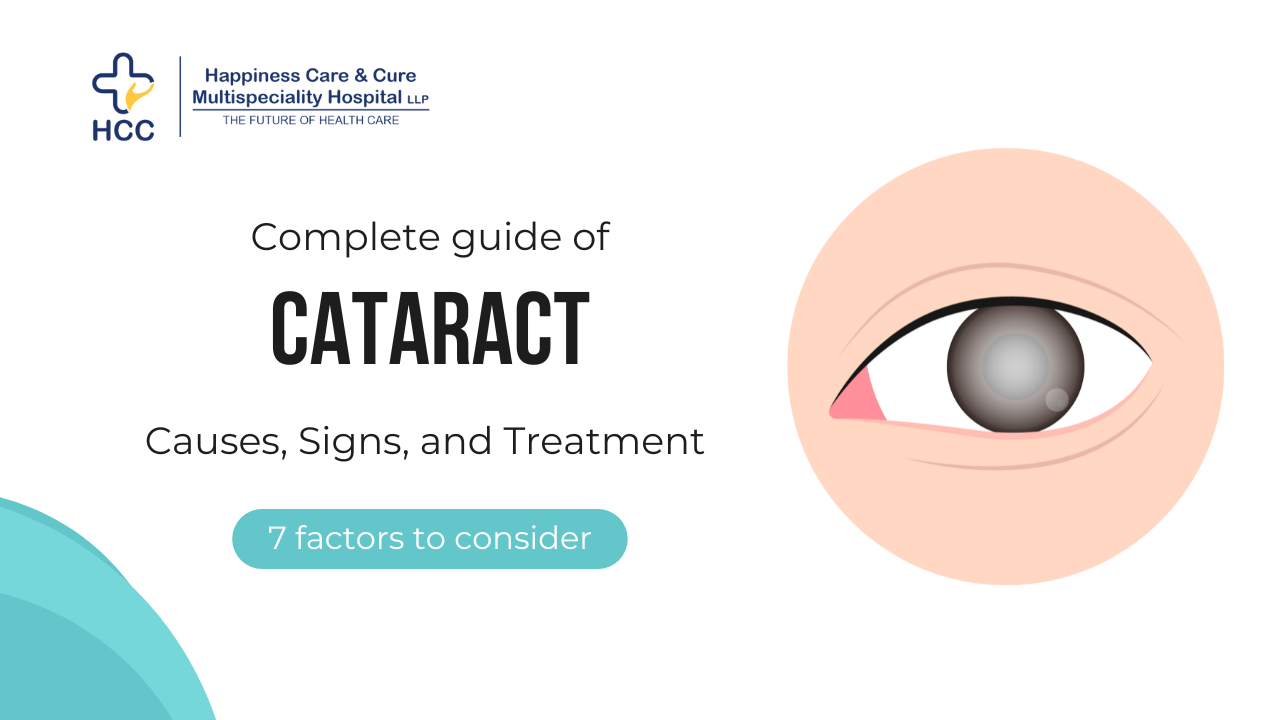
As people age, cataracts are a common vision issue that many people deal with. We will go in-depth on the causes, symptoms, risk factors, prevention techniques, diagnosis, available treatments, recovery, and the significance of maintaining eye health in this comprehensive guide. This article aims to give you helpful insights to comprehend cataracts, whether you're personally dealing with them or are looking for information for a loved one.
What Are Cataracts, First?
Cataracts are the term for the clouding of the eye's lens, which causes a deterioration in vision over time. The normally transparent lens gradually becomes more opaque with age, which alters how light enters the eye. This may cause vision blurriness and a general decline in visual acuity.
Cataract Causes
While age is the main cause of cataracts, other causes include smoking, diabetes, prolonged UV radiation exposure, and certain medications. Additionally, cataract development may be influenced by genetics. It is also thought that the buildup of free radicals in the lens, which harms the lens proteins, plays a role in cataract development.
Typical Symptoms
Early cataracts stages may not show any symptoms, but as the condition worsens, the following symptoms may appear:
- hazy or blurry vision
- heightened sensitivity to glare, particularly from nighttime lights
- seeing clearly at night is challenging
- colors that seem washed out or faded
- prescriptions for eyeglasses frequently changing
Risk Elements
The risk of cataract development can be influenced by a number of factors. These consist of:
- Advanced age: People over 60 are more likely to develop cataracts.
- Diabetes: If untreated, diabetes can hasten the development of cataracts.
- Obesity: Carrying around extra weight has been associated with a higher risk of cataracts.
- Smoking: Smoke from cigarettes contains dangerous chemicals that can harm the lens.
- High blood pressure: Hypertension may aid in the development of cataracts.
- Prolonged use of corticosteroid drugs: Cataracts have been linked to these drugs.
- Family history of cataracts: Some people may be more genetically predisposed to developing cataracts.
Preventative Measures
Although cataracts are frequently an inevitable part of ageing, there are some steps that can be taken to possibly delay their onset:
- UV Protection: Wear sunglasses with the appropriate UV protection to shield your eyes from UV rays, especially when spending a lot of time outside.
- Maintain a nutritious, well-balanced diet that is high in antioxidants. Omega-3 fatty acids and foods high in vitamins C and E may support eye health.
- routine eye exams To keep an eye on your eye health and spot any early signs of cataracts or other vision issues, schedule routine eye exams.
- Health Conditions to Manage: To effectively manage your diabetes or other underlying medical conditions, work closely with your healthcare provider.
Detection
A thorough eye examination by an ophthalmologist can identify cataracts. Your visual acuity will be evaluated, the lens will be checked for cloudiness, and the cataracts' severity will be determined by the eye doctor. A detailed view of the lens and its condition may also be provided using cutting-edge imaging techniques.
Available Therapies
Surgical intervention is frequently advised when cataracts start to significantly interfere with daily activities. The cloudy lens is removed during cataract surgery, and an artificial intraocular lens (IOL) is placed in its place. This outpatient procedure is very effective and can bring back vision clarity. Your lifestyle and visual requirements, among other factors, will influence the IOL you choose.
Intraocular Lens Types
Options exist for the type of IOL that can be implanted in cataract surgery patients. These consist of:
- Monofocal Lenses: Usually used for distance vision, these lenses offer sharp vision at a single distance. For close-up work, reading glasses may still be required.
- Multifocal Lenses: These lenses reduce the need for glasses after surgery by improving vision at different distances.
- Toric lenses: These specialised lenses treat cataracts as well as astigmatism.
Rehabilitation and aftercare
Most patients recover from cataract surgery with better vision within a few days. It's crucial to adhere to your doctor's post-operative recommendations, which may include using the recommended eye drops, refraining from strenuous activity, and attending follow-up appointments. Generally speaking, the healing process is painless, and any discomfort or minor side effects usually go away quickly.
The Value of Good Eye Health
Beyond preventing and treating cataracts, maintaining good eye health is important. For early detection and treatment of a variety of eye conditions, such as glaucoma, macular degeneration, and diabetic retinopathy, routine eye exams are crucial. You can protect your vision and ensure a higher standard of living as you age by giving your eye health top priority.
Finalization
In conclusion, vision loss brought on by cataracts can have a significant negative impact on a person's quality of life. Although they are a normal part of ageing, there are a number of treatments available, such as cataract surgery with various intraocular lenses, that can help restore clear vision and enhance general wellbeing. People can take proactive measures to maintain their vision for years to come by making informed decisions about their eye health by being aware of the causes, symptoms, and treatments that are available.
Remember that putting eye health first through routine examinations, a healthy lifestyle, and preventative measures can significantly reduce the effects of cataracts and other vision-related problems. Since your eyes are so valuable, it is always a wise decision to take preventive measures to look after them. Consult with a qualified eye care professional before starting your path to better eye health to ensure individualized attention and direction catered to your needs.
Make an Appoinment